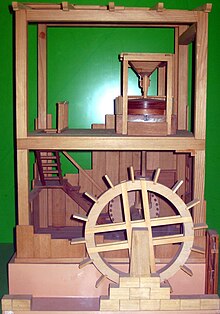
Back تقانة اليونان القديمة Arabic Tecnologia de l'antiga Grècia Catalan Αρχαία ελληνική τεχνολογία Greek Tecnología de la Antigua Grecia Spanish Antiikin Kreikan tekniikka Finnish טכנולוגיה יוונית עתיקה HE Tehnologija stare Grčke Croatian Teknologi Yunani Kuno ID Tecnologia da Grécia Antiga Portuguese Древнегреческие технологии Russian

Ancient Greek technology developed during the 5th century BC, continuing up to and including the Roman period, and beyond. Inventions that are credited to the ancient Greeks include the gear, screw, rotary mills, bronze casting techniques, water clock, water organ, the torsion catapult, the use of steam to operate some experimental machines and toys, and a chart to find prime numbers. Many of these inventions occurred late in the Greek period, often inspired by the need to improve weapons and tactics in war. However, peaceful uses are shown by their early development of the watermill, a device which pointed to further exploitation on a large scale under the Romans. They developed surveying and mathematics to an advanced state, and many of their technical advances were published by philosophers, like Archimedes and Heron.
- ^ a b Wilson, Andrew (2002). "Machines, Power and the Ancient Economy". The Journal of Roman Studies. 92: 1–32 (7f.). doi:10.1017/s0075435800032135. JSTOR 3184857.
- ^ Wikander, Örjan (1985). "Archaeological Evidence for Early Water-Mills. An Interim Report". History of Technology. 10: 151–179 (160).
- ^ Wikander, Örjan (2000). "The Water-Mill". Handbook of Ancient Water Technology. Technology and Change in History. Vol. 2. Leiden: Brill. pp. 371–400 (396f.). ISBN 90-04-11123-9.
- ^ Donners, K.; Waelkens, M.; Deckers, J. (2002). "Water Mills in the Area of Sagalassos: A Disappearing Ancient Technology". Anatolian Studies. 52: 1–17 (11). doi:10.2307/3643076. JSTOR 3643076. S2CID 163811541.
© MMXXIII Rich X Search. We shall prevail. All rights reserved. Rich X Search